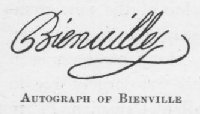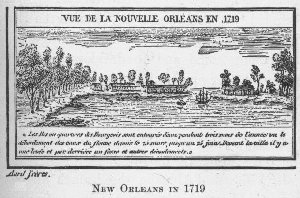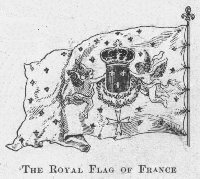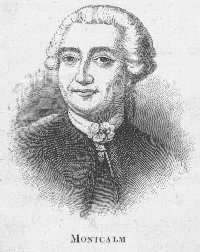THE FRENCH IN THE EIGHTEENTH
CENTURY
The founding of New Orleans. Extent of French possessions. The beginnings of St. Louis. The gateway of Louisiana. Downfall of French power. Louisiana ceded to Spain. American and English explorations. Oregon not included in Louisiana.
While French explorers and traders were following the northern rivers, signs of genuine colonization began to appear in the south. At the beginning of the eighteenth century three countries maintained conflicting claims to the valley of the Mississippi. Spain held Florida and based her claim to the westward on De Soto’s discovery of the great river. France held the upper waters, and La Salle and others had descended the river to its mouth and asserted possession. The charters of some of the English colonies on the seaboard embodied sweeping claims to territory from the Atlantic to the Pacific.
In spite of the doubts of King Louis XIV of France as to the value of the new country, he was finally persuaded to sanction the founding of a French colony at the mouth of the Mississippi. This was largely due to the enthusiasm of a gallant Canadian, Pierre Le Moyne d’Iberville,  who sailed from France with an armed expedition in 1608. The first colony was established the year following at Biloxi, upon the Gulf of Mexico, within the present limits of Mississippi, but its checkered career was ended in 1718, when Bienville d’Iberville, a brother of Le Moyne, founded the city of New Orleans.
who sailed from France with an armed expedition in 1608. The first colony was established the year following at Biloxi, upon the Gulf of Mexico, within the present limits of Mississippi, but its checkered career was ended in 1718, when Bienville d’Iberville, a brother of Le Moyne, founded the city of New Orleans.
The early years of the French colonists were not prosperous. In an effort to make the colony a source of income rather than expense, the king in 1712 gave to Antoine Crozat an exclusive right to trade in that quarter. The failure of this plan resulted in its  abandonment in 1717, and the Company of the West, better known as the Mississippi Company, was formed, which succeeded to Crozat's rights.
abandonment in 1717, and the Company of the West, better known as the Mississippi Company, was formed, which succeeded to Crozat's rights.
Under the leadership of the notorious John Law, who for a time was a financial magnate in France, the company isssued an unlimited amount of paper money wihtout adequate security. This was done in part to further the interests of the company in the Mississippi valley;  but after a period of wild excitement and speculation in France it was found that the paper money could not be exchanged for coin or solid property, and in 1721 there followed collapse, failure, and ruin. This was the end of what is known as the Mississippi Bubble.
but after a period of wild excitement and speculation in France it was found that the paper money could not be exchanged for coin or solid property, and in 1721 there followed collapse, failure, and ruin. This was the end of what is known as the Mississippi Bubble.
In spite of the dismay and suffering caused by this failure, the growth of the colony was quickened during this era of speculation by enforced emigration from France, since it was necessary to settle and develop the new lands as quickly as possible. These troubles, with attacks by the Indians, illness, and lack of proper supplies, clouded the early years of French settlement in Louisiana; but the French remained, and later the colony began to enjoy prosperity.

Thus by discovery, exploration (and to some extent by colonization), and by the building of forts on the north and east, the French held the Mississippi valley, together with the vaguely known empire to the west. The word "colonization" must be accepted with limitations, for neither the French nor the Spanish were led by the motives which caused the English settlers to regard the new country as a permanent home and to develop it for the future as well as for the present. But while New Orleans was struggling through its early years at the mouth of the Mississippi, the French trappers and traders were descending the river from the north.
In 1762 M. d’Abbadie, the French director general of Louisiana, granted to Pierre Laclède, the head of a company of merchants, the exclusive right to trade with the Indians on the Missouri. Two years later this company founded the city of St. Louis, selecting its present site for the erection of a house and four stores. This was the beginning of the city, which for practically a century remained the commercial center of the Louisiana territory. It was here that the American fur trade had its headquarters, and up to nearly the middle of the nineteenth century the traffic in furs was the chief industry of the Louisiana territory.1 As time went on the commerce of the Southwest and of the great river  passed in swelling volume through St. Louis, the gateway of the West; but all this was then in the future. Even before St. Louis was founded a change had come in the fortunes of France. The long warfare between the French and English in North America had culminated, and the rule of France on this continent was ended forever.
passed in swelling volume through St. Louis, the gateway of the West; but all this was then in the future. Even before St. Louis was founded a change had come in the fortunes of France. The long warfare between the French and English in North America had culminated, and the rule of France on this continent was ended forever.
In 1759 the English General Wolfe defeated the French General Montcalm on the Plains of Abraham, under the walls of Quebec. Four years later, in 1763, Fiance ceded to England her American possessions  east of the Mississippi, with the exception of New Orleans.2 But New Orleans and the French possessions west of the Mississippi,—that is, the country of the Louisiana Purchase,—were secretly ceded to Spain by King Louis XV of France, who desired to cement a Spanish alliance.
east of the Mississippi, with the exception of New Orleans.2 But New Orleans and the French possessions west of the Mississippi,—that is, the country of the Louisiana Purchase,—were secretly ceded to Spain by King Louis XV of France, who desired to cement a Spanish alliance.
In 1768 the first Spanish governor appeared at New Orleans, and northward from the sea along the west bank of the Mississippi, fourteen hundred miles, the Spanish authority prevailed. All the traffic down the Mississippi from the valley of the Ohio or elsewhere must pass under the Spanish flag.
The American Revolution was at this time close at hand. Then there came the critical period of the adoption of the Constitution and the organization of the government of the United States, so that the attention of the American people was occupied elsewhere. For nearly forty years the Spaniards, who had been the first to penetrate the Louisiana Purchase, held full possession,. although, as we shall see, France presently undertook to regain the country, and with the growth of the United States west of the Alleghenies the American pressure began to strain the arbitrary boundaries.
The Spaniards made no prolonged explorations to the north, but Americans and English began to investigate the unknown and remote west. Jonathan Carver, a native of New York and an officer in the war with France, suggested an attempt to cross the northwest portion of America by land. This was looked upon as visionary, but in 1766 Carver undertook an exploring expedition in which he followed the Minnesota River for some two hundred miles. The interest of this journey to us lies in the fact that Carver heard much from the Indians regarding the "Shining Mountains," as the Rocky Mountains were termed, and that he learned of the Oregon, or River of the West," which is now the Columbia. It occurred to him that by ascending the Missouri it might be possible to cross to the head waters of the Columbia. But official indifference prevented the attempt. This idea was carried out nearly forty years afterward by Lewis and Clark. Twenty-five years later a Scotchman, Alexander Mackenzie, crossed the continent to the Pacific, but his route lay farther north, through what is now Manitoba and British Columbia.
On the Pacific coast the Spaniards held California, but they knew little of the Northwest. This was reached by the famous explorer, Captain Cook, who visited Alaska in 1778. Vancouver, another English explorer, sailed by the mouth of the Columbia without entering it; this was left for American enterprise. In 1787 some Boston merchants sent Captain Robert Gray in the sloop Washington and Captain John Kendrick in the ship Columbia around Cape Horn to the northwest coast to trade for furs, which were to be exchanged for silk and tea in China. So far as Gray was concerned the journey was successful, and after exchanging ships with Kendrick, Gray returned by way of China in the Columbia, which was the first ship to circumnavigate the globe under the American flag. On this first voyage Gray nearly lost his ship on the bar of an unknown stream, probably the Columbia. On his second voyage, in 1792, he entered and named the great river. His discovery was earlier than that of Vancouver and formed the basis of the subsequent claim to Oregon urged by the United States against Great Britain.3 Gray was followed by other traders, and in a few years a regular trading post was established near the mouth of the Columbia.
While a knowledge of these northwestern explorations is desirable, it should be understood that Oregon, as the northwest beyond the Rocky Mountains was called, was not included in the Louisiana Purchase. The Louisiana Purchase extended only to the Rocky Mountains, but, as it was important to find a way across and to explore the Columbia to the sea, the task of finding a route to the Pacific was included in the instructions to Lewis and Clark.
1The "History of the American Fur Trade," and the "History of Early Steamboat Navigation on the Missouri River," by Captain Hiram M. Chittenden, U.S.A., are indispensable to students of the early nineteenth-century history of the West.
Return to text.
2 In the same year Spain transferred Florida to England in exchange for Havana, but Spain received Florida back in 1783.
Return to text.
3 H. H. Bancroft argues for the discovery of the Columbia by Heceta in 1775, but Gray’s discovery is generally accepted. The rival claims of Gray and Vancouver and their relation to the Oregon question are not essential here.
Return to text.
Chapter 4
Back to Legacy
© 2001, Lynn Waterman